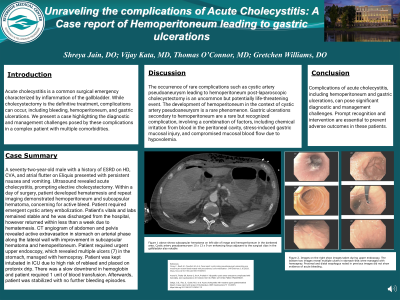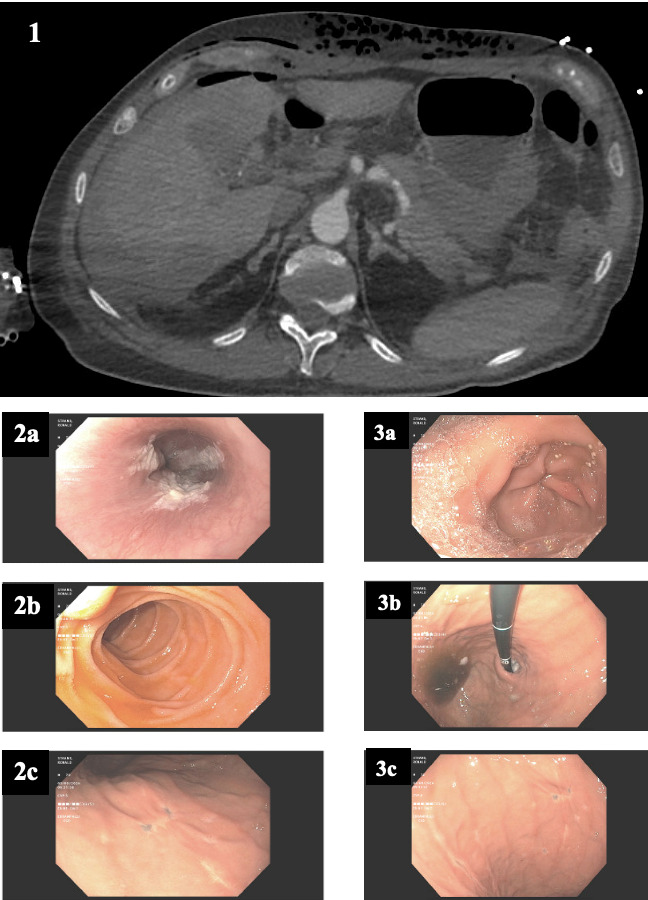Monday Poster Session
Category: Biliary/Pancreas
P1820 - Unraveling the Complications of Acute Cholecystitis: A Case Report of Hemoperitoneum Leading to Gastric Ulcerations
Monday, October 28, 2024
10:30 AM - 4:00 PM ET
Location: Exhibit Hall E

Has Audio
.jpg)
Shreya Jain, DO
Riverside Medical Center
Kankakee, IL
Presenting Author(s)
Shreya Jain, DO1, Vijay Kata, MD2, Thomas O'Connor, MD3, Gretchen Williams, DO1
1Riverside Medical Center, Kankakee, IL; 2Riverside Medical Group, Bourbonnais, IL; 3Riverside Medical Center, Bourbonnais, IL
Introduction: Acute cholecystitis is a common surgical emergency characterized by inflammation of the gallbladder. While cholecystectomy is the definitive treatment, complications can occur, including bleeding, hemoperitoneum, and gastric ulcerations. We present a case highlighting the diagnostic and management challenges posed by these complications in a complex patient with multiple comorbidities.
Case Description/Methods: A seventy-two-year-old male with a history of ESRD on HD, CVA, and atrial flutter on Eliquis presented with persistent nausea and vomiting. Ultrasound revealed acute cholecystitis, prompting elective cholecystectomy. Within a day of surgery, patient developed hematemesis and repeat imaging demonstrated hemoperitoneum and subcapsular hematoma, concerning for active bleed. Patient required emergent cystic artery embolization. Patient’s vitals and labs remained stable and he was discharged from the hospital, however returned within less than a week due to hematemesis. CT angiogram of abdomen and pelvis revealed active extravasation in stomach on arterial phase along the lateral wall with improvement in subcapsular hematoma and hemoperitoneum. Patient required urgent upper endoscopy, which revealed multiple ulcers (7) in the stomach, managed with hemospray. Patient was kept intubated in ICU due to high risk of rebleed and placed on protonix drip. There was a slow downtrend in hemoglobin and patient required 1 unit of blood transfusion. Afterwards, patient was stabilized with no further bleeding episodes.
Discussion: The occurrence of rare complications such as cystic artery pseudoaneurysm leading to hemoperitoneum post-laparoscopic cholecystectomy is an uncommon but potentially life-threatening event. The development of hemoperitoneum in the context of cystic artery pseudoaneurysm is a rare phenomenon. Gastric ulcerations secondary to hemoperitoneum are a rare but recognized complication, involving a combination of factors, including chemical irritation from blood in the peritoneal cavity, stress-induced gastric mucosal injury, and compromised mucosal blood flow due to hypovolemia.
Complications of acute cholecystitis, including hemoperitoneum and gastric ulcerations, can pose significant diagnostic and management challenges. Prompt recognition and intervention are essential to prevent adverse outcomes in these patients.

Disclosures:
Shreya Jain, DO1, Vijay Kata, MD2, Thomas O'Connor, MD3, Gretchen Williams, DO1. P1820 - Unraveling the Complications of Acute Cholecystitis: A Case Report of Hemoperitoneum Leading to Gastric Ulcerations, ACG 2024 Annual Scientific Meeting Abstracts. Philadelphia, PA: American College of Gastroenterology.
1Riverside Medical Center, Kankakee, IL; 2Riverside Medical Group, Bourbonnais, IL; 3Riverside Medical Center, Bourbonnais, IL
Introduction: Acute cholecystitis is a common surgical emergency characterized by inflammation of the gallbladder. While cholecystectomy is the definitive treatment, complications can occur, including bleeding, hemoperitoneum, and gastric ulcerations. We present a case highlighting the diagnostic and management challenges posed by these complications in a complex patient with multiple comorbidities.
Case Description/Methods: A seventy-two-year-old male with a history of ESRD on HD, CVA, and atrial flutter on Eliquis presented with persistent nausea and vomiting. Ultrasound revealed acute cholecystitis, prompting elective cholecystectomy. Within a day of surgery, patient developed hematemesis and repeat imaging demonstrated hemoperitoneum and subcapsular hematoma, concerning for active bleed. Patient required emergent cystic artery embolization. Patient’s vitals and labs remained stable and he was discharged from the hospital, however returned within less than a week due to hematemesis. CT angiogram of abdomen and pelvis revealed active extravasation in stomach on arterial phase along the lateral wall with improvement in subcapsular hematoma and hemoperitoneum. Patient required urgent upper endoscopy, which revealed multiple ulcers (7) in the stomach, managed with hemospray. Patient was kept intubated in ICU due to high risk of rebleed and placed on protonix drip. There was a slow downtrend in hemoglobin and patient required 1 unit of blood transfusion. Afterwards, patient was stabilized with no further bleeding episodes.
Discussion: The occurrence of rare complications such as cystic artery pseudoaneurysm leading to hemoperitoneum post-laparoscopic cholecystectomy is an uncommon but potentially life-threatening event. The development of hemoperitoneum in the context of cystic artery pseudoaneurysm is a rare phenomenon. Gastric ulcerations secondary to hemoperitoneum are a rare but recognized complication, involving a combination of factors, including chemical irritation from blood in the peritoneal cavity, stress-induced gastric mucosal injury, and compromised mucosal blood flow due to hypovolemia.
Complications of acute cholecystitis, including hemoperitoneum and gastric ulcerations, can pose significant diagnostic and management challenges. Prompt recognition and intervention are essential to prevent adverse outcomes in these patients.

Figure: Figure 1 above shows subcapsular hematoma on left side of image and hemoperitoneum. Cystic artery pseudoaneurysm 10 x 13 x 9 cm enhancing focus adjacent to the surgical clips in the gallbladder also notable.
Figure 2. Images on the right show images taken during upper endoscopy. 2c and 3c reveal multiple ulcers in stomach that were managed with hemospray. Images 2a, 2b, 3a, 3b show proximal and distal esophagus, which do not show evidence of acute bleeding.
Figure 2. Images on the right show images taken during upper endoscopy. 2c and 3c reveal multiple ulcers in stomach that were managed with hemospray. Images 2a, 2b, 3a, 3b show proximal and distal esophagus, which do not show evidence of acute bleeding.
Disclosures:
Shreya Jain indicated no relevant financial relationships.
Vijay Kata indicated no relevant financial relationships.
Thomas O'Connor indicated no relevant financial relationships.
Gretchen Williams indicated no relevant financial relationships.
Shreya Jain, DO1, Vijay Kata, MD2, Thomas O'Connor, MD3, Gretchen Williams, DO1. P1820 - Unraveling the Complications of Acute Cholecystitis: A Case Report of Hemoperitoneum Leading to Gastric Ulcerations, ACG 2024 Annual Scientific Meeting Abstracts. Philadelphia, PA: American College of Gastroenterology.
